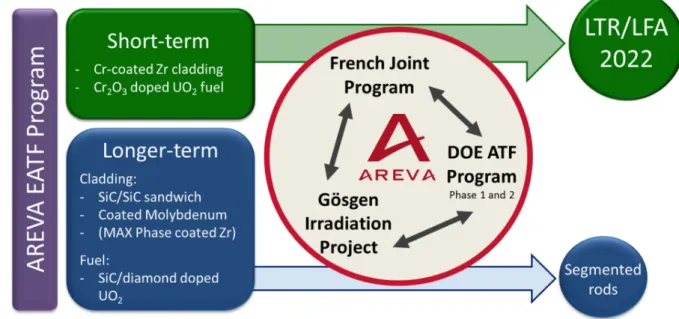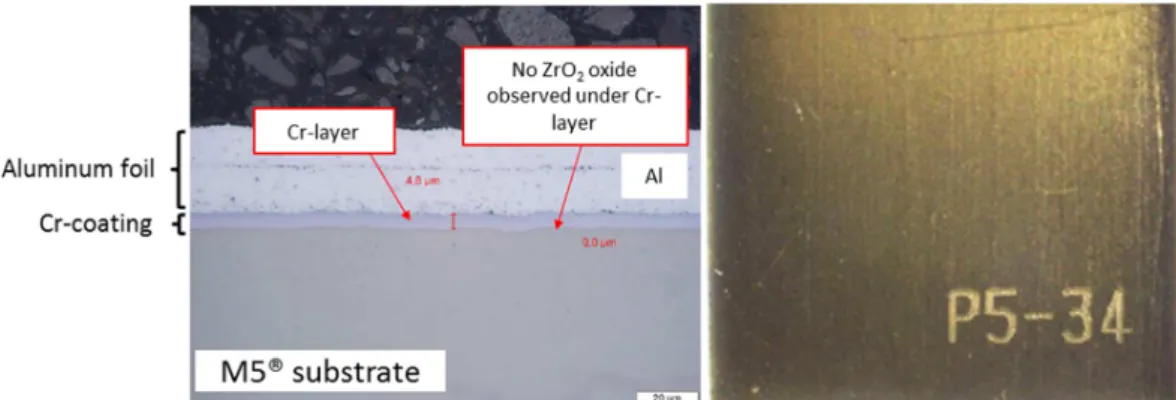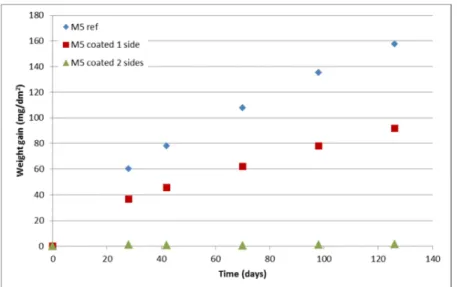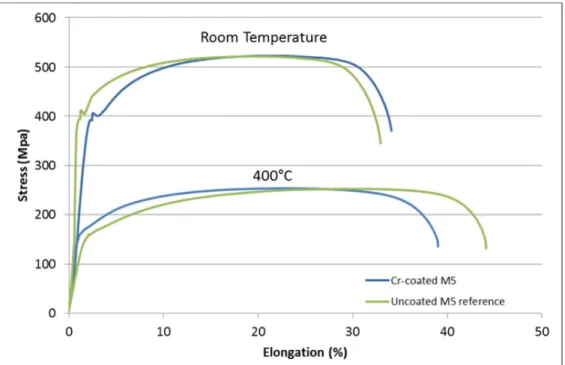HAL Id: cea-02438699
https://hal-cea.archives-ouvertes.fr/cea-02438699
Submitted on 27 Feb 2020
HAL is a multi-disciplinary open access
archive for the deposit and dissemination of
sci-entific research documents, whether they are
pub-lished or not. The documents may come from
teaching and research institutions in France or
abroad, or from public or private research centers.
L’archive ouverte pluridisciplinaire HAL, est
destinée au dépôt et à la diffusion de documents
scientifiques de niveau recherche, publiés ou non,
émanant des établissements d’enseignement et de
recherche français ou étrangers, des laboratoires
publics ou privés.
Development of Cr-coated Zirconium Alloy Cladding for
Enhanced Accident Tolerance
J. Bischoff, C. Vauglin, C. Delafoy, P. Barberis, D. Perche, B. Guerin, J.-P.
Vassault, J.-C. Brachet
To cite this version:
J. Bischoff, C. Vauglin, C. Delafoy, P. Barberis, D. Perche, et al.. Development of Cr-coated Zirconium
Alloy Cladding for Enhanced Accident Tolerance. Topfuel 2016 - Light Water Reactor (LWR) Fuel
Performance Meeting, Sep 2016, Boise, United States. �cea-02438699�
Development of Cr-coated Zirconium Alloy Cladding for
Enhanced Accident Tolerance
Jeremy Bischoff,
1aChristine Vauglin,
1aChristine Delafoy,
1aPierre Barberis
,
1bDelphine Perche,
1cBernard Guerin
1d, Jean-Paul Vassault
1b, Jean-Christophe
Brachet
,
2a1a
Department of Fuel Design - Materials, AREVA NP, Lyon, France, 69456
1bDepartment of Fuel Manufacturing, Component Research Center, AREVA NP, Ugine, France, 73403 1cDepartment of Chemistry and Corrosion, Le Creusot Technical Center,AREVA NP, Le Creusot, France, 71205
1dDepartment of Fuel Manufacturing, Component Research Center, AREVA NP, Paimboeuf, France, 44560 2aCEA, DEN, DMN, SRMA, Université Paris-Saclay, 91191 Gif-sur-Yvette, France
Corresponding author: Jeremy Bischoff, +33 4 72 74 74 49, e-mail: jeremy.bischoff@areva.com
Abstract. During the Fukushima Daiichi accident in 2011 the fuel rods underwent the degradation stages of a severe accident, including the rapid oxidation of zirconium, which led on the one hand to the production of large quantities of hydrogen, and on the other hand to additional heat production.Reducing the susceptibility of the cladding to the high temperature oxidation in steam can improve greatly the accident tolerance of the cladding and thus help reduce the risk of core meltdown. The worldwide research and development effort of the fuel nuclear industry to increase fuel margins in severe accidents is referenced as the development of Enhanced Accident Tolerant Fuels (EATF). In this context AREVA NP, along with CEA and EDF, is developing, among others, a chromium (Cr) coating (5-20µm thick) on zirconium alloy cladding. The coating is deposited on the cladding surface by Physical Vapor Deposition (PVD) and forms a dense and adherent protective layer. It preserves the good mechanical behavior of the current cladding in normal operating conditions while significantly improving the oxidation behavior in accidental conditions. This behavior is being evaluated through out-of-pile corrosion and mechanical tests at the AREVA NP Technical and Research Centers. The corrosion behavior was evaluated through autoclave tests in both PWR water chemistry at 360°C and in 415°C steam to increase the corrosion kinetics. In both cases very small weight gain was measured on the order of 1mg/dm2 and remains stable throughout the length of the tests.
This development is a part of the worldwide AREVA NP effort to improve the accident tolerance of the fuel through several projects and partnerships, in both Europe and the USA. In the USA, AREVA NP is strongly involved in the Department of Energy (DOE) program whose goal is to insert EATF solutions in US Light Water Reactors (LWRs) by 2022. In Europe, AREVA NP is on one side developing two cladding solutions (Cr-coated zirconium and SiC/SiC composite sandwich cladding) with the CEA and EDF, and on the other side is forming a partnership with the Gösgen utility to irradiate some EATF concepts under representative Pressurized Water Reactor (PWR) conditions.
Keywords: Cladding, Accident Tolerant Fuels (ATF), Cr-coating, Physical Vapor Deposition (PVD), Corrosion.
INTRODUCTION
The current nuclear fuel rod concept for Light Water Reactors (LWRs) of UO2 pellets enclosed in zirconium alloy
cladding has been used and optimized to improve its safety, reliability, and performance, leading to the development of advanced zirconium alloys, such as M5®. Following the Fukushima Daiichi accident in 2011 where the fuel rods
underwent the degradation stages of a severe accident, including the rapid oxidation of zirconium, the nuclear industry began investigating fuel and cladding concepts to enhance the fuel rod’s accident tolerance and increase margins in severe accident conditions [1]. This international development effort is known as “Enhanced Accident Tolerant Fuels” (EATF), and it focuses primarily on improving the cladding’s high temperature steam oxidation behavior to limit both the heat production and hydrogen production originating from the high temperature steam oxidation of zirconium alloys. By reducing the steam oxidation kinetics, EATF solutions can also impact the high temperature mechanical behavior by limiting the ingress of oxygen (and hydrogen) in the zirconium alloy, thus inhibiting its embrittlement and subsequent potential failure.
In this context AREVA NP has investigated several cladding concepts ranging from evolutionary to revolutionary solutions with various implementation times and potential severe accident performance benefits [2]. AREVA NP’s worldwide EATF effort is composed of two tightly linked programs: a European program including the cladding material developments performed in the French Joint R&D Program and their subsequent irradiation in the Gösgen reactor, and the participation to the United States’ Department of Energy (DOE) project. The two programs are linked in the fact that the developments performed within the French Joint Program are used in support of the DOE program. Figure 1 summarizes schematically the organization of AREVA NP’s worldwide EATF program divided into two main categories of solutions investigated: short and long term. The short-term solution is the combination of Cr2O3-doped UO2 fuel with Cr-coated zirconium alloy cladding, and the development goal is to introduce full
length Lead Test Rods (LTR) or Lead Fuel Assemblies (LFA) before 2022. For the longer-term solutions, the development effort will focus on SiC/SiC sandwich cladding with the goal of inserting segmented test rods by 2022.
FIGURE 1. Schematic of AREVA’s worldwide EATF program
Concerning the developments in the United-States, another paper will describe the work completed within the DOE ATF program during Phase 1, where several cladding options were investigated: MAX phase coatings on zirconium alloys, and coated Mo cladding (development performed in collaboration with EPRI) [3]. For Phase 2 of this program AREVA NP will focus on its short-term solution combining Cr-coated zirconium alloy cladding with Cr2O3-doped fuel. In this concept both the doped fuel and the Cr-coated cladding bring significant advantages in
accident conditions that complement each other. For example during a LOCA transient, the reduced fission gas retention of the fuel leads to decreased internal rod pressure, which limits the ballooning of the cladding which is also reinforced by the Cr-coating on the cladding , thus reducing the risk of cladding burst. During the oxidation and quench part of the transient the Cr-coated cladding significantly limits the oxidation and helps preserve post-quench ductility.
This paper will focus on the European program and more specifically on the development of the Cr-coated zirconium (Zr) alloys, with results from the experiments performed at the AREVA NP Technical and Research
Centers. The analyses performed at AREVA NP facilities aim to evaluate the normal operating condition behavior of the Cr-coated cladding while the CEA focuses on the high temperature conditions and accidental behavior, which will be presented in another paper [4]. Within the French Joint Program, on top of the Cr-coated zirconium alloy cladding, SiC/SiC composite sandwich cladding is also developed as a more revolutionary and therefore longer term cladding concept.
Additionally, a collaborative project with the Gösgen plant in Switzerland is ongoing to verify the performance of these cladding solutions in representative pressurized water reactor (PWR) conditions, with insertion of material samples planned in mid-2016
RESULTS ON CR-COATED ZIRCONIUM ALLOY CLADDING
Description and Fabrication
Scoping studies were performed by the CEA with a wide range of coating materials (both ceramic and metallic coatings, either mono or multi-layered) to determine the most appropriate coating material. Metallic chromium coating was selected as it provides the optimal compromise between high corrosion resistance, excellent coating adherence, and reasonable neutron transparency (thermal neutron absorption cross-section of 3.1 barns) [5]. The Cr-coating thickness envisioned ranges between 5 and 20µm.
Cr-coated zirconium alloy cladding exhibits significantly reduced high temperature steam oxidation kinetics, which leads to considerably reduced heat and hydrogen production, as normally observed during the high temperature steam oxidation of uncoated zirconium alloys. Furthermore, the Cr-coating protects the underlying substrate from oxygen or hydrogen ingress, thus inhibiting the formation of the brittle Zr-α(O) phase leading to a considerable improvement of the post-quench ductility of the cladding. The ductility of the Cr-coated cladding is indeed similar before and after high temperature oxidation and therefore retains its integrity even after relatively long exposure to high temperature steam for a 15µm thick Cr coating up to at least 6000s at 1200°C as was shown in previous articles [2, 6]. Consequently, the use of Cr-coated zirconium cladding is expected to improve the coping time (before occurrence of rod fragmentation upon or after quenching) in severe accident conditions by a couple of hours at 1200-1300°C up to about 5 to 10 hours at 1000°C depending on the Cr-layer thickness. This solution is therefore a near term evolutionary solution which will provide important benefits in Design Based Accident (DBA)-LOCA and severe accident conditions.
To produce Cr-coated cladding samples, pure Cr is deposited on the surface of the samples using a special Physical Vapor Deposition (PVD) process. This technique forms a very dense coating with no cracks in the Cr-layer nor porosity present at the Cr-Zr interface, thus providing excellent adherence, as described in a previous article [6]. Currently the size of the PVD furnace facilitates coating tubes up to 50cm long. The industrialization of the coating process is feasible since some companies use PVD to coat large surfaces on the industrial scale with corresponding quality control, and this will be demonstrated on commercial length zirconium alloy cladding tubes. For this purpose, AREVA NP has launched a process development program to fabricate full length Cr-coated tubes with the ultimate goal to have a robust process to coat commercial length (5m) tubes.
Corrosion Behavior
Corrosion in autoclave in 360°C water
Cr-coated zirconium alloy samples were exposed in autoclave at 360°C at the AREVA NP Technical center in the following pressurized water reactor (PWR) chemistry conditions:
• Deaerated solution (<10ppb) dissolved O2 and no added H2
• [H3BO3] = 650 ppm
After the end of each test period, the water chemistry was analyzed and no Cr was detected in solution. This confirms that there is no dissolution of the Cr-layer in the water under these conditions and that it is very adherent to the substrate. The samples were corroded up to an exposure time of 180 days.
Figure 2 shows the corrosion kinetics of Cr-coated samples for M5®, and Zy4. The tube samples are coated only on the external surface and therefore the weight gain of the tube samples mainly comes from the corrosion of the uncoated zirconium inner surface. This explains why the tube samples exhibit about half the weight gain of the reference uncoated samples in all cases. It is to be noted that the corrosion kinetics of zirconium alloys, and especially Zy4 (as observed in Figure 2), is not continuous with time for these test conditions but follows a sequence of weight-gain periods, leading to the periodic structure of the zirconium oxide formed. Additionally, flat corrosion coupon samples were coated on all surfaces, and therefore are the ones giving the representative corrosion kinetics and behavior of the Cr-coating. These samples exhibit very low weight gain (on the order of 1mg/dm2) demonstrating the extremely low corrosion kinetics of Cr-coated zirconium alloys in autoclave. Similar results are obtained for several zirconium alloy substrates (M5® and Zy-4) confirming the good reproducibility and robustness of the coating process and the negligible impact of the underlying substrate on the corrosion properties of a Cr-coated sample.
FIGURE 2. Corrosion kinetics of Cr-coated M5® and Zy4 samples exposed to 360°C PWR water
Figure 3 shows the optical micrograph of the cross-section and a general overview of the surface of a Cr-coated zirconium sample after corrosion in 360°C PWR water after 30 days of exposure. The aluminum present in the micrograph is used for sample preparation. The sample surface overview shows a light golden color with no delamination of the Cr-coating. The golden color suggests that the Cr2O3 layer is less than 100 nm thick and changes towards bluish/purple tints as the Cr oxide thickness increases. This suggests that the oxide layer formed stays on the order of a few hundred nanometers, and does not change much. This is confirmed by the cross-section, which shows the Cr-coating and the underlying substrate but without visible outer Cr2O3 oxide scale, due to its very
limited thickness which needs higher magnification and SEM-FEG or TEM examinations to be highlighted. Furthermore, no evidence of ZrO2 is seen under the Cr-coating, thus demonstrating that the Cr-coating is highly
protective against corrosion with no diffusion of oxygen (and hydrogen) through the Cr-layer.
FIGURE 3. Optical micrograph of the cross-section and general visual aspect of an M5® Cr-coated sample after corrosion in
Corrosion in autoclave in 415°C steam
The excellent corrosion behavior was confirmed by tests performed at the AREVA NP Research Center in 415°C steam to accelerate the corrosion process and therefore evaluate the corrosion behavior in more aggressive conditions. Figure 4 shows the corrosion kinetics in this environment for samples coated with Cr and compared to a reference M5®. Once again, samples coated on only one-side exhibit half the weight gain of the uncoated reference, demonstrating that the Cr-coated side does not oxidize much and mainly the uncoated side forms an oxide. The samples coated on both sides exhibit very small weight gain that remains almost constant on the order of 1mg/dm2.
FIGURE 4. Corrosion kinetics of Cr-coated M5® and Zy4 samples exposed to 415°C steam
Additionally, some Cr-coated samples were scratched intentionally all the way through the Cr-coating thickness to simulate damage to the Cr-coating prior to testing in 415°C steam. The goal was to have a conservative approach concerning potential handling damages or potential surface defects of the Cr-coating. For example during rod insertion in the fuel assembly structure some scratches may appear on the Cr-coating (this will be investigated in the near future). After corrosion, the pre-damaged samples showed no delamination of the Cr-layer and exhibited similar weight gains to undamaged Cr-coated samples with no exacerbated zirconium alloy corrosion observed at the scratch location. This confirms that the coating is very adherent and that its performance is maintained even when locally flawed. Figure 5 shows an intentionally scratched Cr-coated M5® sample before and after corrosion in steam at 415°C for 28 days.
FIGURE 5. Visual aspect of an intentionally scratched M5® Cr-coated sample before and after corrosion in 415°C steam
Mechanical Behavior
The mechanical behavior of Cr-coated samples was evaluated through tensile tests on Cr-coated and uncoated M5® tube samples at both room temperature and 400°C. These tests were performed at AREVA Research Centers and enable the comparison of the mechanical properties of coated versus uncoated tube samples. Figure 6 shows an
example of the stress-strain curves for reference uncoated M5® and Cr-coated M5® at room temperature and 400°C. The curves demonstrate that the Cr-coated samples exhibit similar mechanical behavior as uncoated samples, and for all the tests performed, the mechanical properties (yield strength 0.2%, ultimate tensile strength, and total elongation) of the Cr-coated samples all fell within the range of values for uncoated samples. The slight differences observed between the coated and uncoated M5® data are not significant since within the range of data obtained for reference samples. Consequently, the mechanical behavior of Cr-coated samples can be approximated by that of the underlying zirconium alloy substrate. This suggests that the licensing of Cr-coated zirconium alloy cladding may be greatly simplified by relying on the properties of the underlying substrate, which is already licensed. To confirm this statement, AREVA NP has launched an irradiation program to study the mechanical behavior of the Cr-coated zirconium alloy cladding under representative PWR conditions. This irradiation program is briefly described hereafter.
FIGURE 6. Tensile tests at room temperature and 400 °C of Cr-coated M5® compared to uncoated reference M5®.
IRRADIATION PROJECT IN GÖSGEN REACTOR
Gösgen plant and AREVA NP have a long lasting collaboration in the development and implementation of new fuel, aimed at improving the safety and performance of the reactors. This cooperation has been confirmed recently through a multi-year contract for broad fuel R&D developments, including an irradiation project of EATF solutions in the Gösgen reactor. This irradiation project is called IMAGO, which stands for Irradiation of Materials for Accident tolerant fuels in the GÖsgen reactor. The goal of IMAGO is to verify the behavior of EATF solutions in representative PWR conditions, mainly the corrosion behavior, the microstructural evolution under irradiation and some mechanical properties. Both Cr-coated zirconium alloy and SiC/SiC composite cladding samples are planned to be inserted by mid-2016 in the form of material test rods (MTRs) placed within the guide tubes of some fuel assemblies. IMAGO will be the first irradiation of EATF solutions in a commercial reactor and will serve as a stepping stone to obtain in-pile data for the justification of future fuel rod irradiations.
CONCLUSION
AREVA NP has a worldwide EATF program with work being performed in the United States as part of the DOE project, and, within the French Nuclear Collaborative program with CEA and EDF. Two cladding solutions are being developed in Europe and are planned to be irradiated in the Gösgen reactor mid-2016: Cr-coated zirconium alloys and SiC/SiC composite sandwich cladding. Concerning the Cr-coated cladding, AREVA NP is investigating the behavior under normal operating conditions while the CEA focuses on the accidental behavior. The current results show extremely low corrosion kinetics in representative PWR autoclave tests and the mechanical test results show no significant difference of the Cr-coated cladding mechanical properties from that of the underlying substrate (uncoated zirconium cladding). These results combined with the very good accidental behavior presented previously suggest that the Cr-coated cladding solution is very promising and would provide significant benefits. To obtain in-pile data as early as possible on this solution, AREVA and Gösgen are launching an irradiation program called IMAGO to verify the behavior of the Cr-coated cladding in representative PWR conditions. This will be the first irradiation of EATF solutions in a commercial reactor. Consequently, it is a solution that could be implemented in a relatively short time frame and full length Lead Test Rods or Lead Fuel Assemblies are planned before 2022.
ACKNOWLEDGMENTS
The authors would especially like to thank Kernkraftwerk Gösgen-Däniken AG for their collaboration in the irradiation of EATF samples in the Gösgen reactor, and their support for the licensing of the Material test Rods and future examination of the samples.
The developments on-going in the United States are based upon work supported by the U.S. Department of Energy under Award Number DE-NE0000567 with AREVA Federal Services LLC.
M5® is a registered trademark of AREVA NP in the U.S.A. or other countries.
REFERENCES
[1] “The Fukushima Daiichi Nuclear Power Plant Accident: OECD/NEA Nuclear Safety Response and Lessons Learnt”, NEA N°7161, OECD (2013)
[2] J. Bischoff, K. McCoy, J. Strumpell, J-C. Brachet, C. Lorrette, “Development of Fuels with Enhanced Accident Tolerance”, in proceedings of Top Fuel 2015, Zurich, Switzerland, September 13-17, (2015).
[3] J. Stevens, K. Nimishakavi, B. Mays, J. Strumpell, “AREVA Enhanced Accident Tolerant Fuel Program – Current Results and Future Plans”, in proceedings of TopFuel 2016, Boise, Idaho, United States, September 11-16, (2016).
[4] J.C. Brachet, M. Le Saux, V. Lezaud-Chaillioux, M. Dumerval, Q. Houmaire, E. Rouesne, S. Urvoy, T. Guilbert, J. Rousselot, F. Lomello, F. Schuster, A. Billard, E. Monsifrot, J. Bischoff, E. Pouiller, “Behavior under LOCA conditions of Enhanced Accident Tolerant Chromium Coated Zircaloy-4 Claddings”, in proceedings of TopFuel 2016, Boise, Idaho, United States, September 11-16, (2016).
[5] I. Idarraga-Trujillo, M. Le Flem, J-C. Brachet, M. Le Saux, D. Hamon, S. Muller, V. Vandenberghe, M. Tupin, E. Papin, E. Monsifrot, A. Billard, and F. Schuster, “Assessment at CEA of Coated Nuclear Fuel Cladding For LWRs with Increased Margins In LOCA and Beyond LOCA Conditions”, in proceedings of Top Fuel 2013, Charlotte, NC, USA, September 15-19, (2013).
[6] J.C. Brachet, M. Le Saux, M. Le Flem, S. Urvoy, E. Rouesne, T. Guilbert, C. Cobac, F. Lahogue, J. Rousselot, M. Tupin, P. Billaud, C. Hossepied, F. Schuster, F. Lomello, A. Billard, G. Velisa, E. Monsifrot, J. Bischoff, A. Ambard, “On-Going Studies at CEA on Chromium Coated Zirconium Based Nuclear Fuel Claddings for Enhanced Accident Tolerant LWR Fuel”, in proceedings of Top Fuel 2015, Zurich, Switzerland, September 13-17, (2015).



